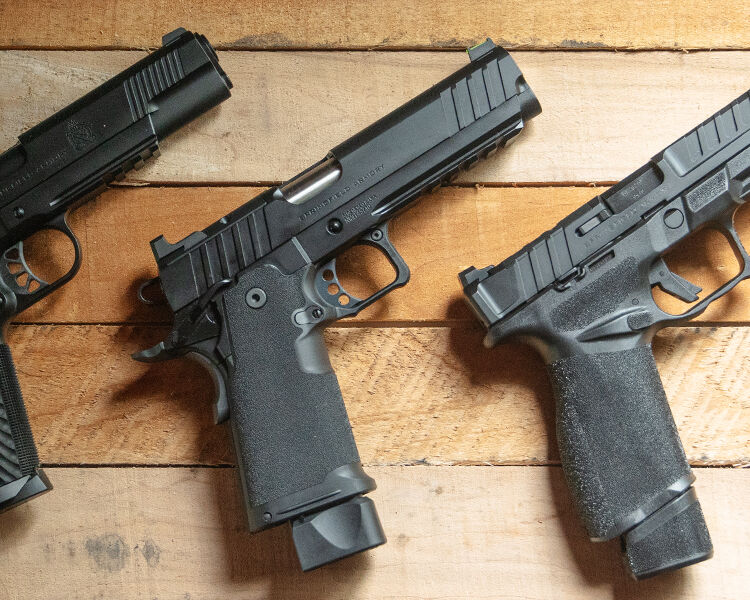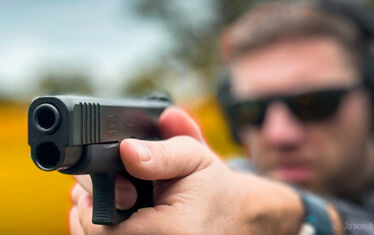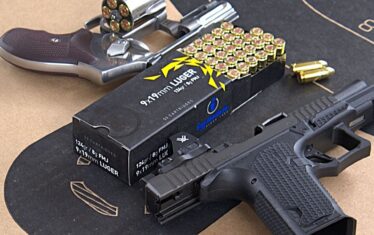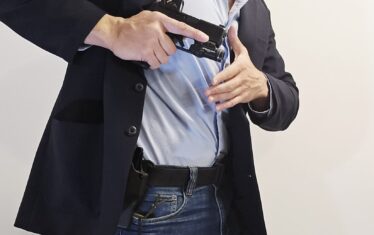A duty pistol is a powerful thing. Think back to Clint Eastwood wielding his cannon of a service revolver in “Dirty Harry” or Tom Hanks going down swinging with his 1911 in “Saving Private Ryan.” Somehow picking out a duty pistol just feels more personal than buying a rifle or shotgun.
But what is a duty pistol, and how has the concept changed through the years? The plastic fantastics you see in service with military units and police departments around the world are a far cry from the heavy metal of a century ago, but there’s a direct connection between the two.
Plenty of manufacturers still build the revered 1911. A few make modernized 2011 variants. Almost all pistol manufacturers make some kind of polymer striker-fired pistol. Interestingly enough, Springfield Armory makes all three. I grabbed one of each to experience the evolution of the duty pistol for myself.
1911 TRP: A Modern Classic
You can make the case that the 1911 is America’s original duty pistol. It entered service with the U.S. Military in 1911 and remained the nation’s fighting pistol for more than 70 years.
Today, the 1911 market is filled with everything from entry-level pistols to heirloom collectibles. The Springfield Armory 1911 TRP is the highest you can climb on the company’s 1911 hierarchy before getting into custom gunsmithing.
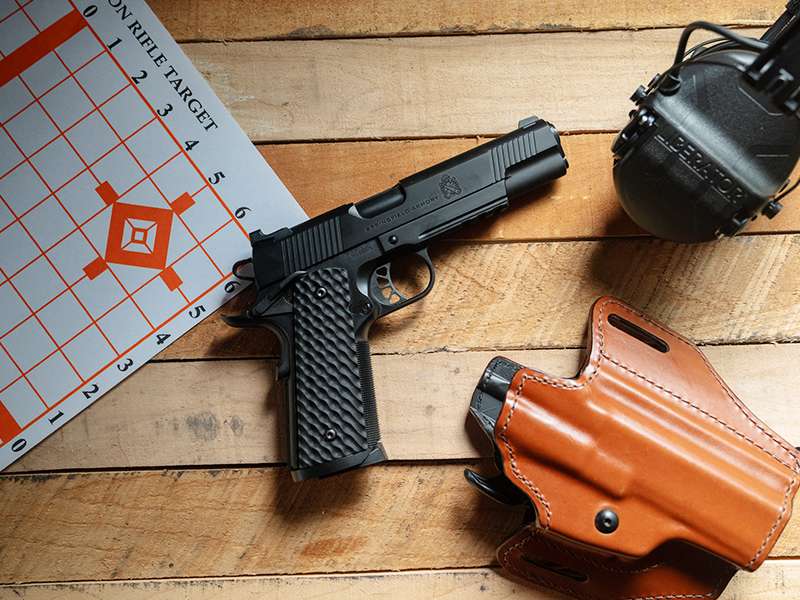
This is one fancy pistol. The frame and slide are hand-fitted and individually numbered to create a perfect fit. That doesn’t mean it’s not duty-grade, though.
It traces its roots back to the 1990s when the FBI asked Springfield to develop a pistol for its Hostage Rescue Team. The result was the Tactical Response Pistol, a 1911 with carefully chosen modifications and upgrades to make it an effective duty pistol more than 75 years after its release.
In addition to hand-fitting, the pricy TRP (with a starting MSRP of $1,732) gets a flared magazine well, an ambidextrous thumb safety, tritium night sights, front and rear cocking serrations, a grooved slide to reduce glare, and a rugged Cerakote finish.
Oh — and don’t forget a Gen 2 Speed Trigger that will change your life.
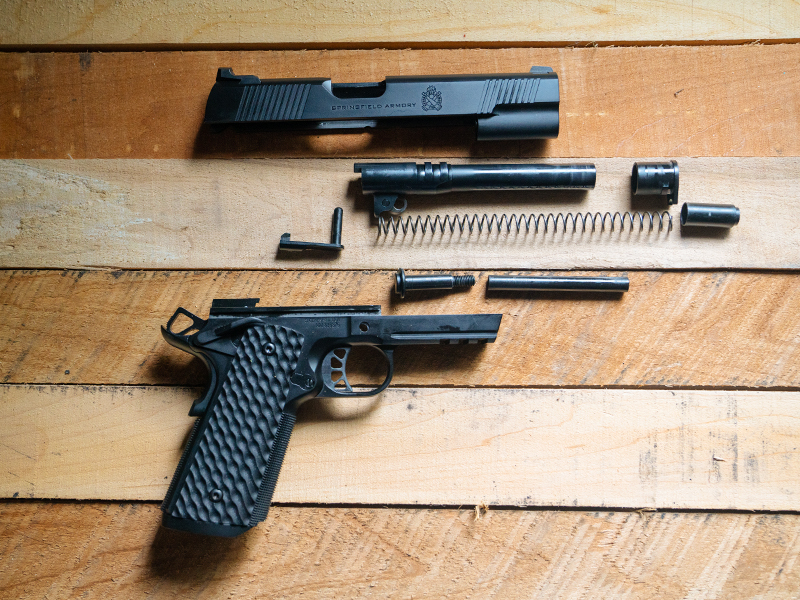
So how does it stack up as a modern duty pistol?
The merits of lobbing 230 grains of lead stand on their own. It’s a potent cartridge. The 1911 TRP takes everything we love about the 1911 platform and dials it up to ten. The craftsmanship is incredible. The fit, finish, and attention to detail are almost an art form. Shooting this pistol is a rare experience.
There are some drawbacks, though.
While you can certainly count on it to save your life, it wouldn’t be my recommendation for a hard-charging duty pistol. Its capacity is limited in comparison to modern standards and you can’t add a red dot. It takes far more attention and maintenance than a modern striker-fire pistol to run reliably.
Besides, not many police departments, military units, or civilians are flush enough to afford a $2,000 duty pistol.
It’s an exquisite firearm and a stirring reminder of how much the platform has accomplished. But is it a contender for Duty Pistol of the Year? That’s no longer the 1911’s role.
Prodigy: Something Old, Something New
Enter the Springfield Prodigy, a 9mm double-stack 1911 that blurs boundaries in the pistol market. Is it a race gun, a duty gun, or a little of both?
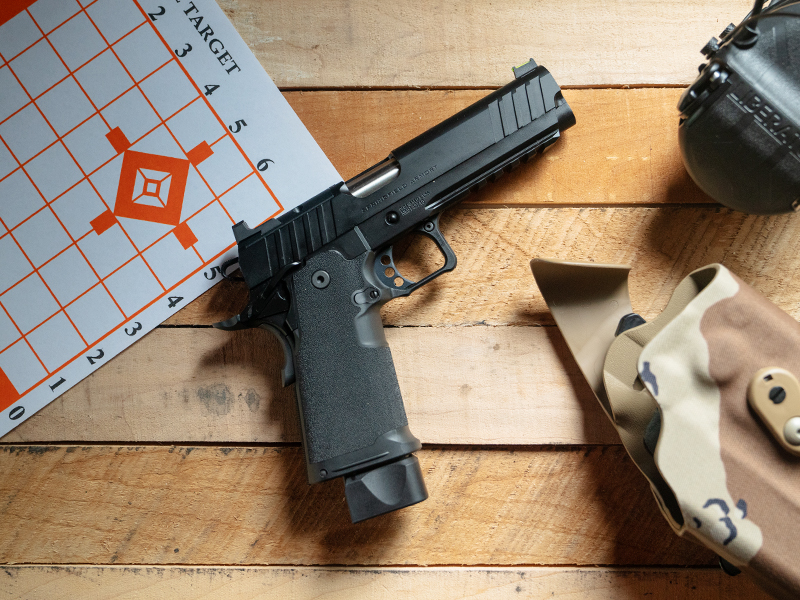
Think of this pistol as a 1911 that’s widened to accommodate a double-stack 9mm magazine — in this case, with a 17-, 20-, or 26-round capacity. It has a bull barrel to improve accuracy, absorb heat, and mitigate recoil. The slide is optic-ready with adapter plates and suppressor-height sights are tall enough to co-witness with the Vortex Defender-XL I tested.
You only have to empty one magazine to appreciate why this style of pistol is so popular in the world of competitive shooting. The trigger is outstanding, the recoil is minimal, and the accuracy is impressive. If you can handle the weight of a Prodigy and don’t mind a manual thumb safety, why not carry this as a duty pistol?
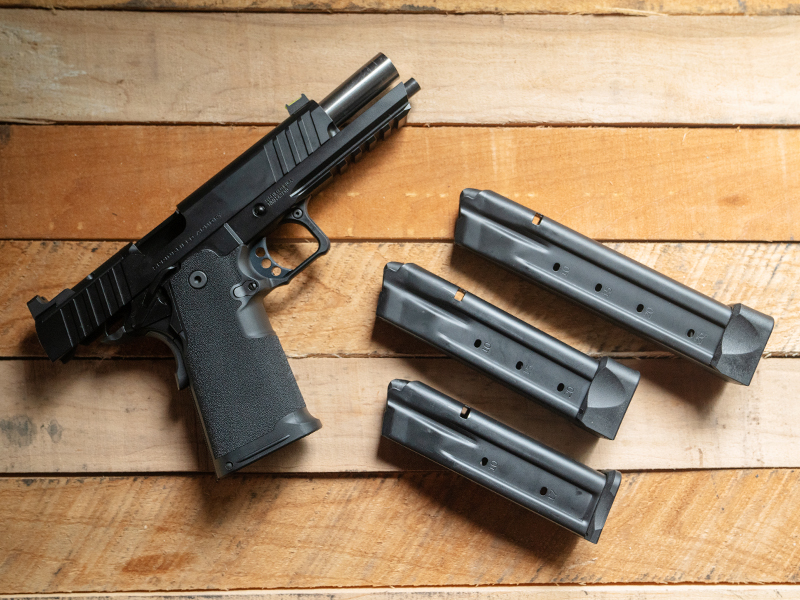
The Prodigy (and other pistols that use this platform) carry over many features of the 1911 — that can be a good or bad thing in different situations.
While I welcomed the excellent trigger and the gentle push of recoil instead of a 9mm pistol’s typical snap, I felt like I was stepping back in time whenever I disassembled the Prodigy to clean it. Magazines are very expensive and tend to be a little bit glitchy regardless of who builds them.
While it ran without a hiccup for me when it was clean and well-lubricated (I eventually ran into a few stovepipes), this platform doesn’t thrive on hard use and lax maintenance like many modern pistols do.
My advice? Enjoy this pistol for what it is. Keep it on the range where it can run fast, demolish the clock, and put you on the podium. Don’t ask a racehorse to charge into battle.
Echelon: Welcome To The Future
When I spoke to the Springfield team at SHOT Show 2024, they said that offering up one new feature is not enough to stand out in the current pistol market; you have to get more radical.
To that end, the product developers create the Springfield Echelon. Yes, it’s tough. Yes, it’s accurate. Its spec sheet also reads like a wishlist of our favorite features.
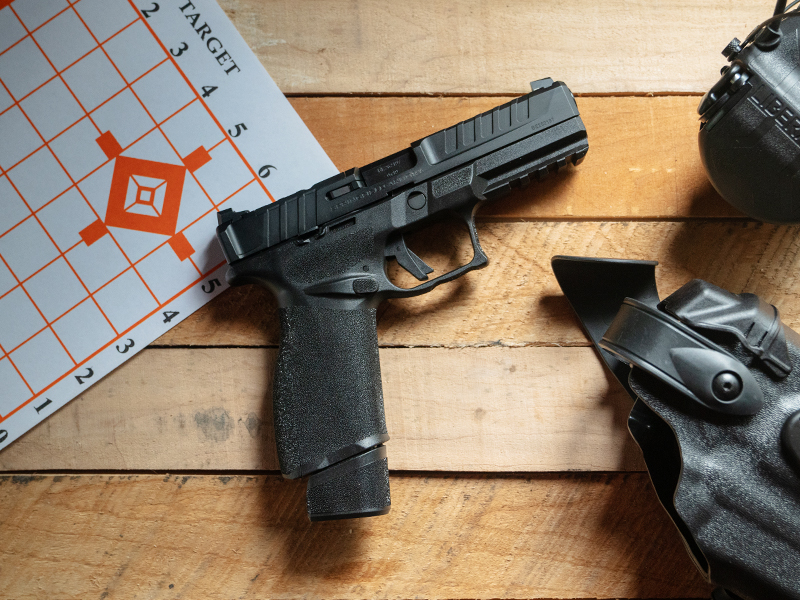
The serialized trigger group lets owners swap out grip modules without going through an FFL. Create your perfect fit with three grip sizes and three backstrap sizes in black, flat dark earth, or olive drab green.
The slide stop and magazine release are ambidextrous. The extended take-down lever doubles as a gas pedal to take recoil and allow faster follow-up shots. Prominent front and rear serrations and a flared slide make racking and press-checking easy, even in gloves.
The Echelon is compatible with weapon lights and red dots (as are most duty pistols), but there’s something revolutionary about Springfield’s new optic mounting system.
Instead of committing to one optic footprint or making customers order an adapter plate to mount the optic of their choice, Springfield’s Variable Interface System uses clever inserts to create compatibility with more than 30 pistol optics.
You’ll probably be able to co-witness with the stock U-Notch or tritium sights, but suppressor-height sights are available, too.
Shooting the Echelon is intuitive to anyone who’s handled a striker-fire pistol. The trigger is quite nice and the sights allow rapid target acquisition. The low bore axis reduces recoil and the grip facilitates high, firm hand placement.
The first time I took the Echelon to the range, I felt like I’d been shooting it for years. It — combined with a Vortex Defender-ST red dot, Streamlight TLR-1 HL weapon light, and Safariland 6360RDS holster — makes a very compelling case for why your next duty pistol should be an Echelon.
In a word, this pistol is easy. It’s easy to shoot, easy to accessorize, and easy to perform basic maintenance. If you’re shopping for a workhorse of a sidearm, that’s music to your ears.
What Defines a Duty Pistol?
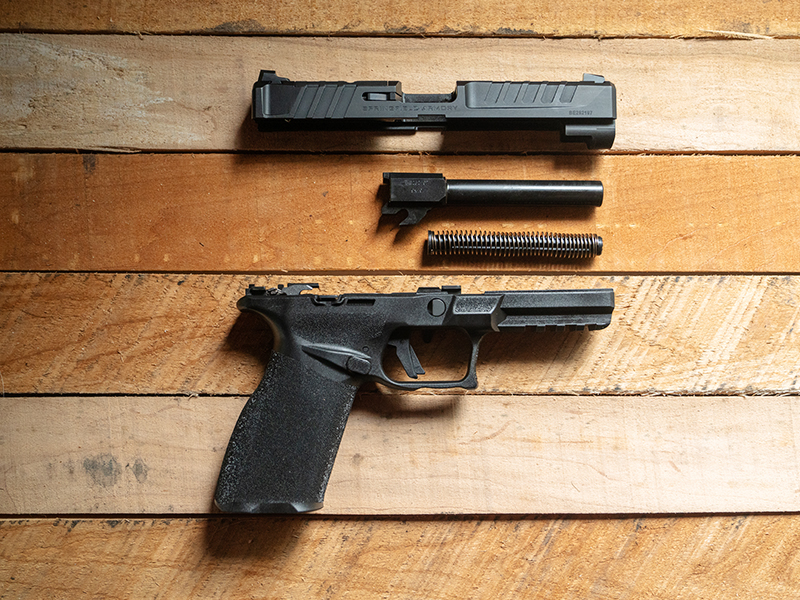
People who carry a gun for a living have relied on duty pistols since the early 1900s when they started phasing out duty revolvers. There have been countless makes and models, but you’ll spot a few commonalities.
Duty pistols are generally full-size. They’re reliable. They carry plenty of ammunition, and they take advantage of all the latest tech to give you a competitive edge. That looks different now than it did at the beginning of the 20th century, but the principles hold true.
Duty Pistol Holster Considerations
Duty holsters face a unique challenge because we have to assume that not only will we need to access the pistol quickly, we need to ensure that others can’t. It’s a simple balancing act: speed against security.
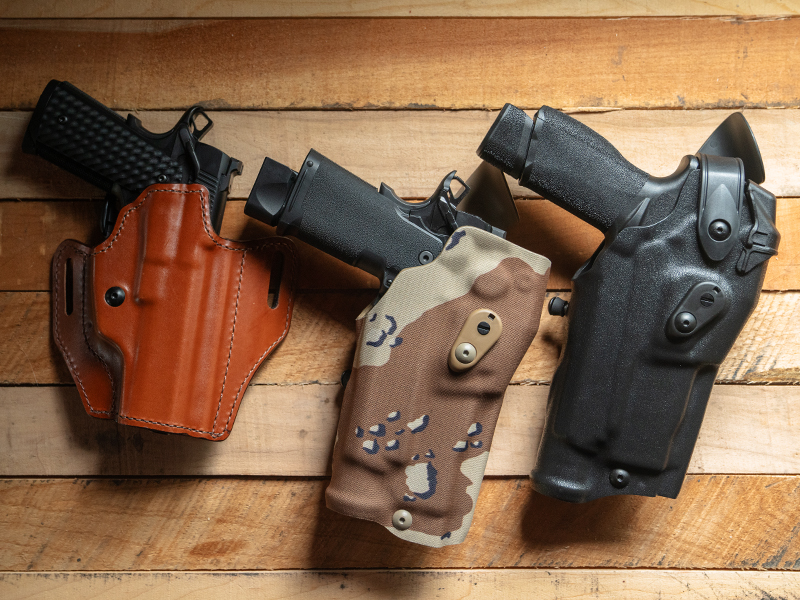
That means open holsters — whether Kydex or leather — are out. They’re fast and simple to operate but offer no security. Likewise, a holster that’s totally secure but won’t let you draw in a timely fashion is a non-starter.
Safariland classifies holster retention by how many separate actions are required to remove the pistol.
Holsters like the Safariland 6354RDSO (pictured with the Prodigy) offer Level I retention. Press the thumb lever to the rear, and the pistol slides right out. The Bianchi 126GLS (pictured with the 1911 TRP) uses a similar mechanism; press the lever forward with your middle finger to release the lock.
The Safariland 6360RDS (pictured with the Echelon) is a Level III holster. To draw, you have to press the thumb pad down, push the hood forward, and retract the same lever used by Level I holsters. It’s easy to do this quickly with some training but nobody is going to snatch your pistol off your belt without you knowing.
There Can Be Only One
So, do all three of these pistols have a place in today’s market? Yes, but not in the same market segment. Shooting all three makes it very clear that these are different evolutions of the duty pistol concept.

The clear winner — if you’re looking for a duty pistol, anyway — is the Echelon. The folks at Springfield outdid themselves with this one.
The Echelon is intuitive to shoot well, stone simple to maintain, effortless to customize, and the price is right. Of the three, this is the duty pistol to have.





